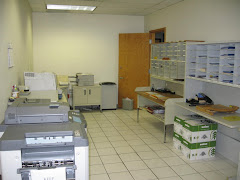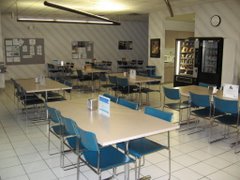Due to the soft Arizona economy, our facility has relocated our furniture building into a much smaller space. In the distribution world, more space isn't always better than less space. In our case, we were able to make several improvements in our process through relocation.
First, we moved more product into our primary building. This translates to a higher percentage of orders being filled from our primary building and improves our productivity rates. We will spend less time off site at the satellite building and there will be less time spent driving between the two buildings because only one trip per shift will be required.
Second, the new building is much closer to our primary building. Our previous satellite building was 15 minutes away, so 30 minutes was spent daily driving for each trip. The new facility is 3 minutes away, so 6 minutes for each trip. Obviously, there is a gain of 24 minutes per trip, with two associates in the truck, for a gain of 0.8 labor hours per trip.
Couple those results with the reduction of one trip on average per night and the labor savings is 1.8 hours per day or just over 450 labor hours per year! That is equal to gaining a full time associate for 11 weeks at no cost! This is LEAN at its best, a true reduction of transportation waste!
Third, because we have much less space, we pay a lot less for that space. Our rent expense for off-site space will decline by nearly 80%, a very significant savings.
So we spend less money and increase warehouse productivity at the same time. These are the gains we look for all the time with LEAN production!
Tuesday, November 25, 2008
T-Outs Kaizen Team
In theory, inventory on hand for a given item should always be accurately reflected in the computer inventory file. Inaccuracies can cause us to either carry more inventory than we need for a given item, or to disappoint a customer by not being able to fill an order we thought we could fill. From a LEAN perspective, both are problems to be corrected by tightening processes to maintain strong inventory control. If we have 100 widgets on the shelf, our computer system should say we have 100 widgets as well.
 Several times per day, our computer system communicates to our customers that we have an item in stock, but it is not available on the shelf when the warehouse associate goes to pick the item for the order. This situation is called a T-Out in Phoenix, and our objective is to have as few as possible. In October and November, our T-Out rate in Phoenix was too high at 0.13%. Our target is 0.10%.
Several times per day, our computer system communicates to our customers that we have an item in stock, but it is not available on the shelf when the warehouse associate goes to pick the item for the order. This situation is called a T-Out in Phoenix, and our objective is to have as few as possible. In October and November, our T-Out rate in Phoenix was too high at 0.13%. Our target is 0.10%.
During the 3rd week of November, we gathered a Kaizen team to look at our T-Outs and see if we could bring them down below our target. The team included six associates, two from inventory control, two from the receiving and put away shift, and two from the order fulfillment shift. They determined there are four significant opportunities for improvement that, if improved, will reduce T-Outs in Phoenix. Those key opportunities are Housekeeping, Pick Accuracy, Product Astray, Low Stock on Hand. The team created a RASIC chart with all action items to improve each area, a person assigned as responsible, and a completion date. We expect to see a 40% reduction in T-Outs, beginning as early as late December.
 Several times per day, our computer system communicates to our customers that we have an item in stock, but it is not available on the shelf when the warehouse associate goes to pick the item for the order. This situation is called a T-Out in Phoenix, and our objective is to have as few as possible. In October and November, our T-Out rate in Phoenix was too high at 0.13%. Our target is 0.10%.
Several times per day, our computer system communicates to our customers that we have an item in stock, but it is not available on the shelf when the warehouse associate goes to pick the item for the order. This situation is called a T-Out in Phoenix, and our objective is to have as few as possible. In October and November, our T-Out rate in Phoenix was too high at 0.13%. Our target is 0.10%.During the 3rd week of November, we gathered a Kaizen team to look at our T-Outs and see if we could bring them down below our target. The team included six associates, two from inventory control, two from the receiving and put away shift, and two from the order fulfillment shift. They determined there are four significant opportunities for improvement that, if improved, will reduce T-Outs in Phoenix. Those key opportunities are Housekeeping, Pick Accuracy, Product Astray, Low Stock on Hand. The team created a RASIC chart with all action items to improve each area, a person assigned as responsible, and a completion date. We expect to see a 40% reduction in T-Outs, beginning as early as late December.
Subscribe to:
Posts (Atom)

